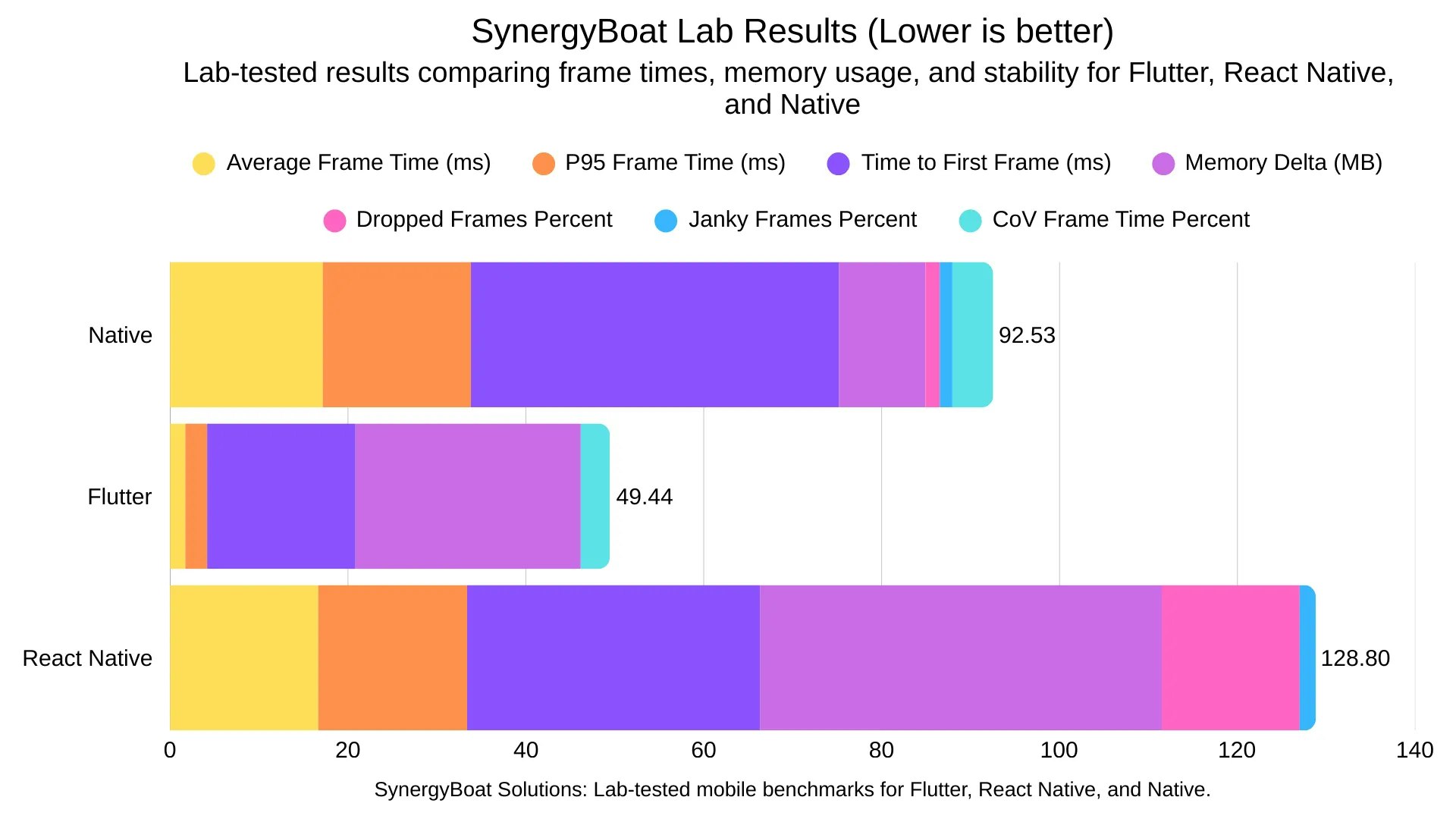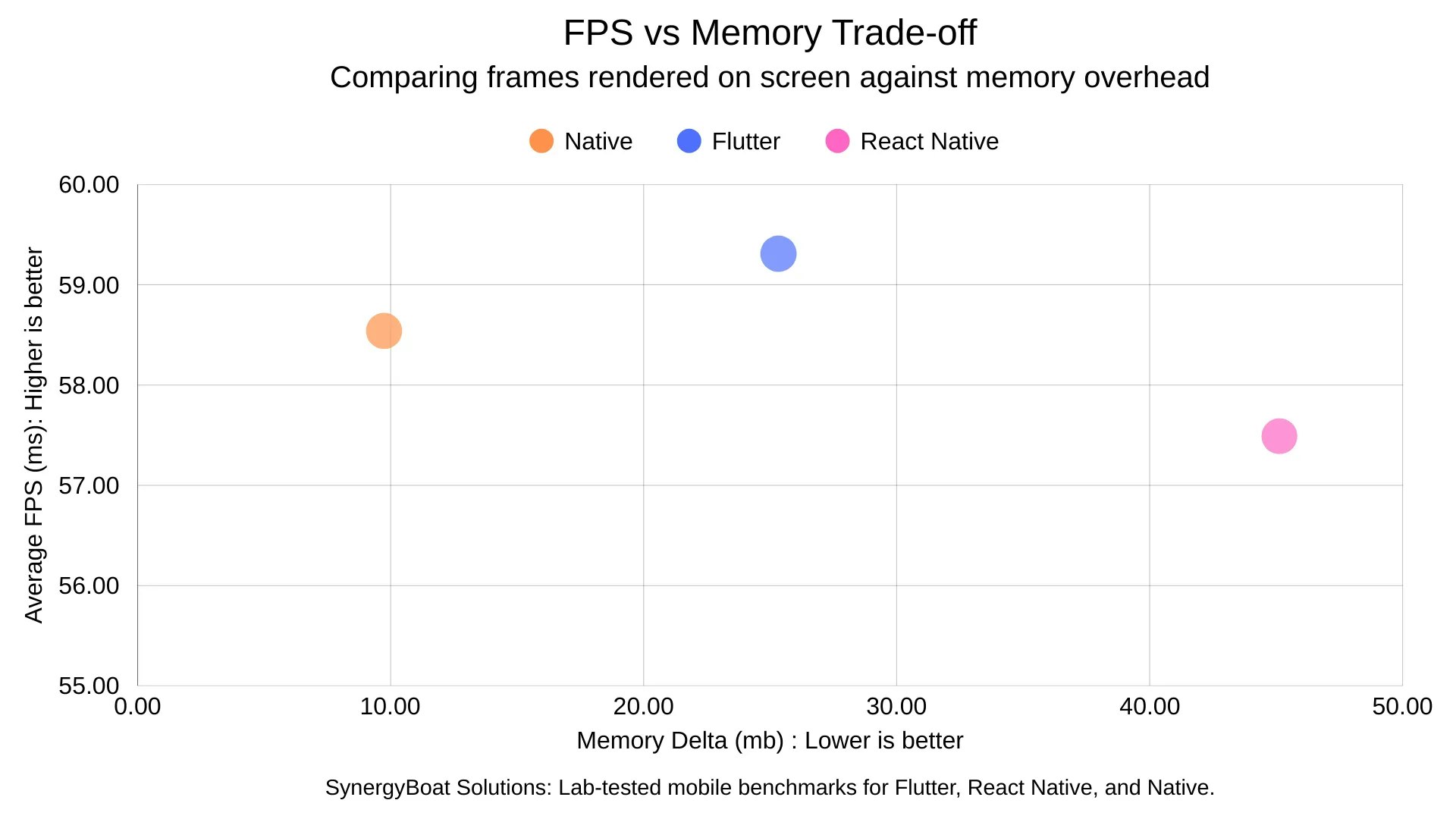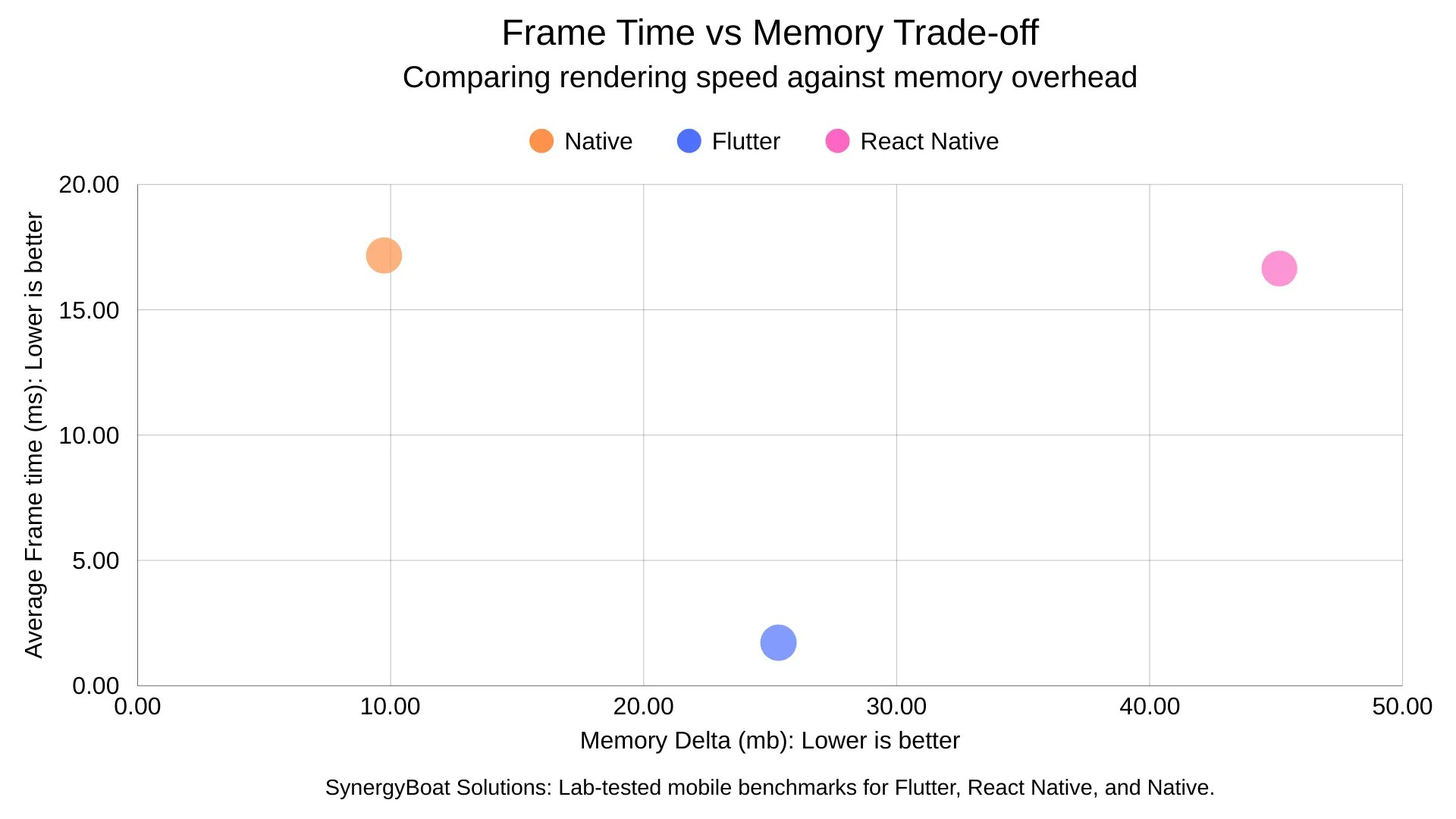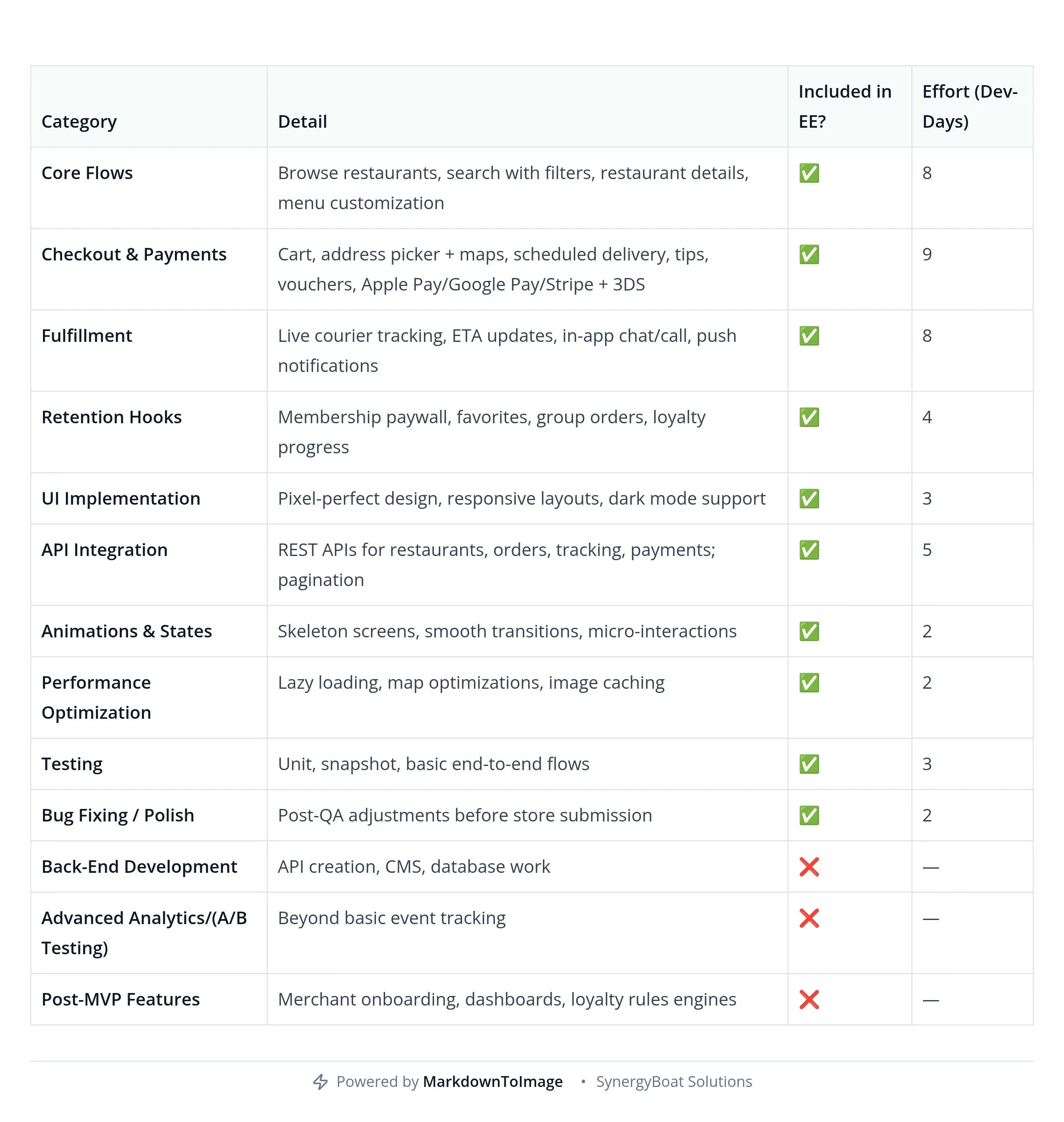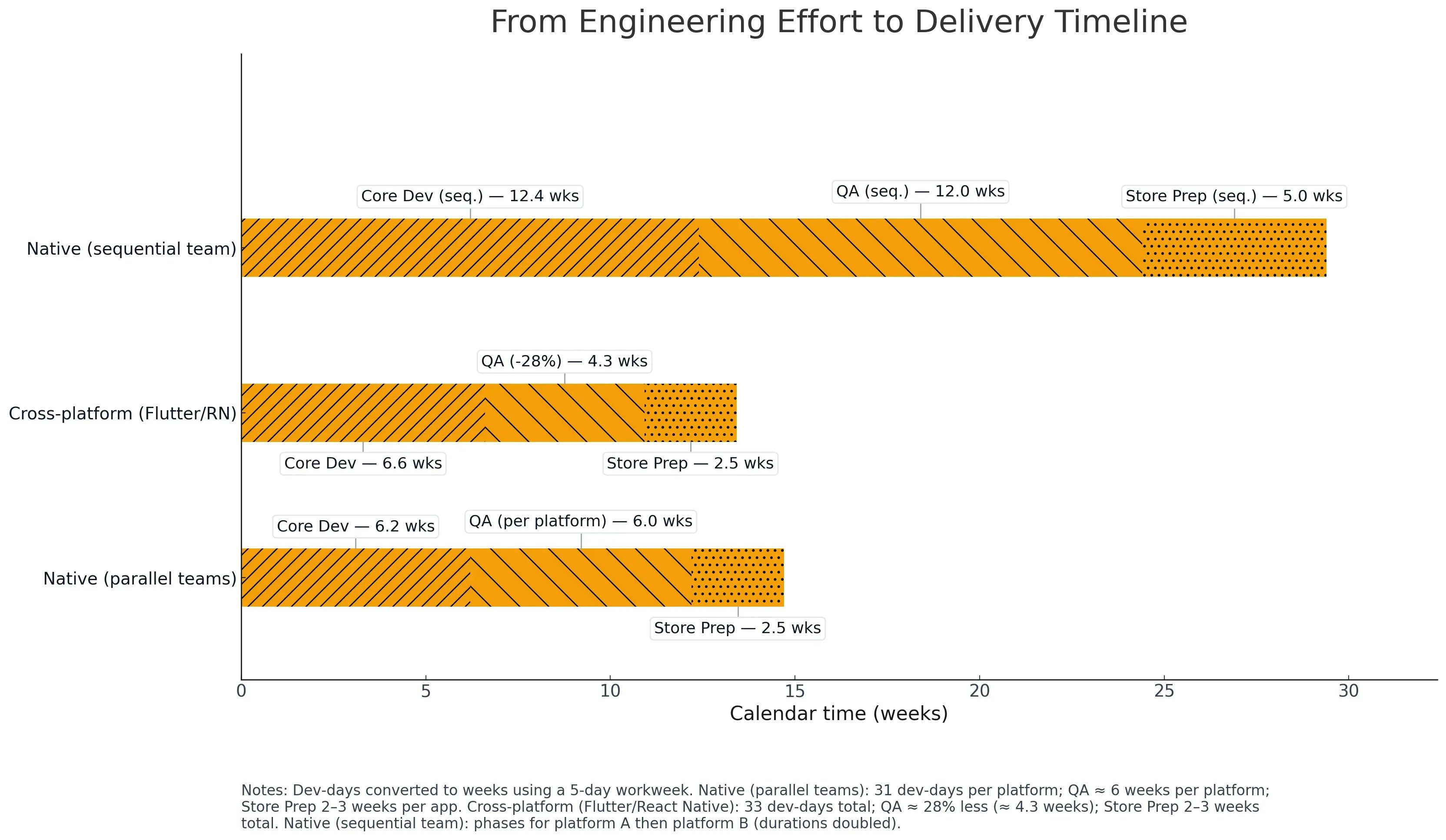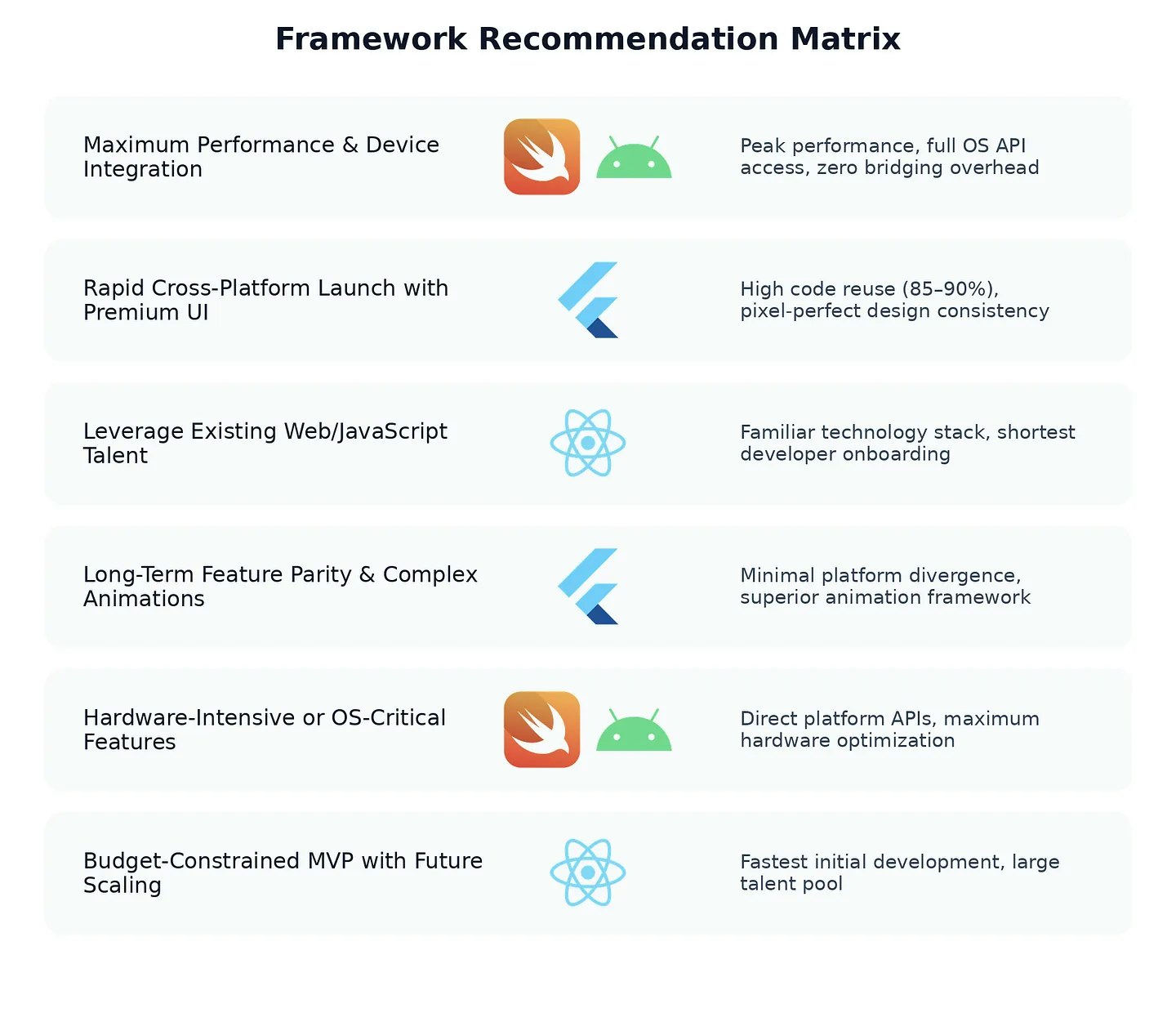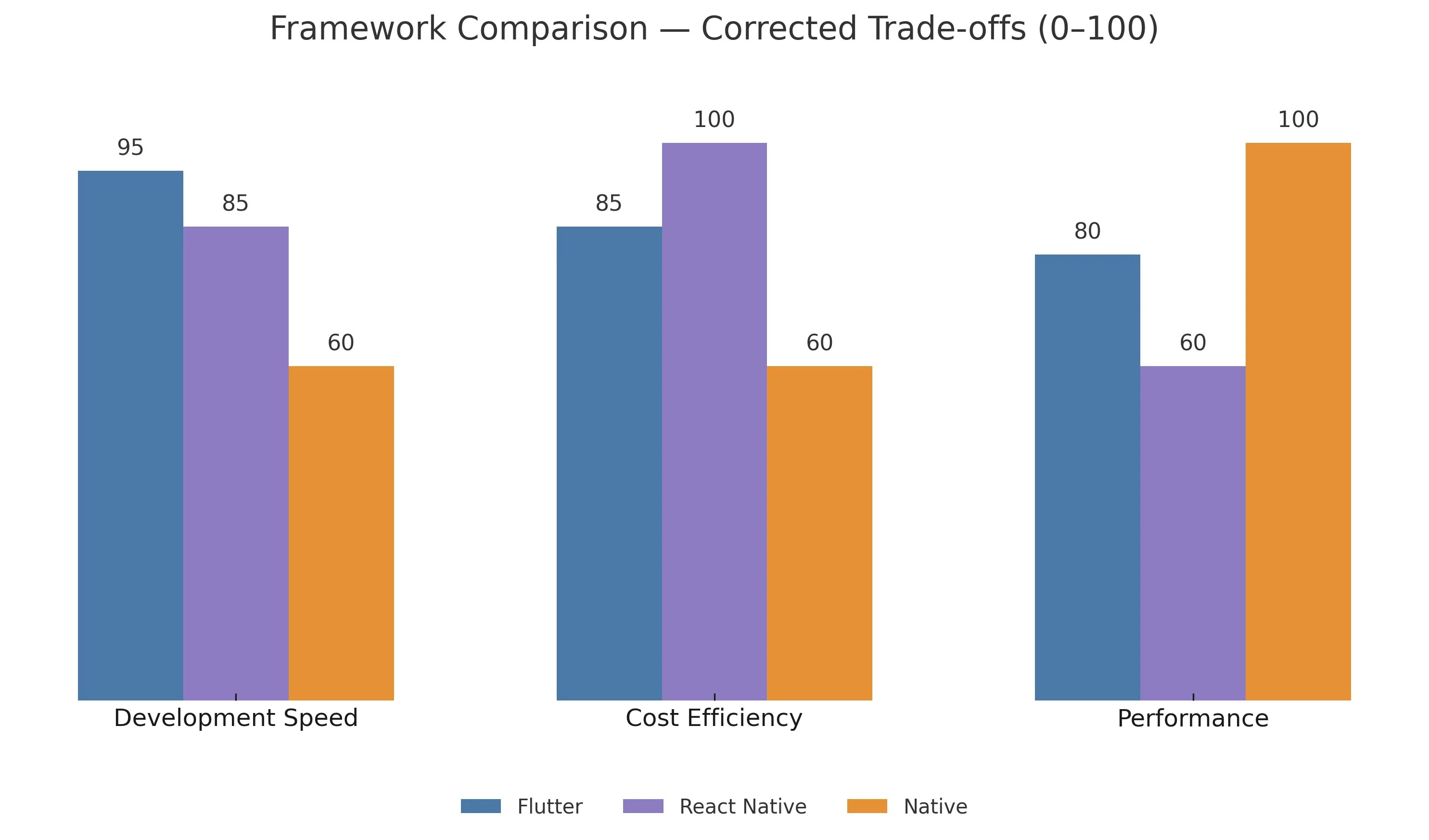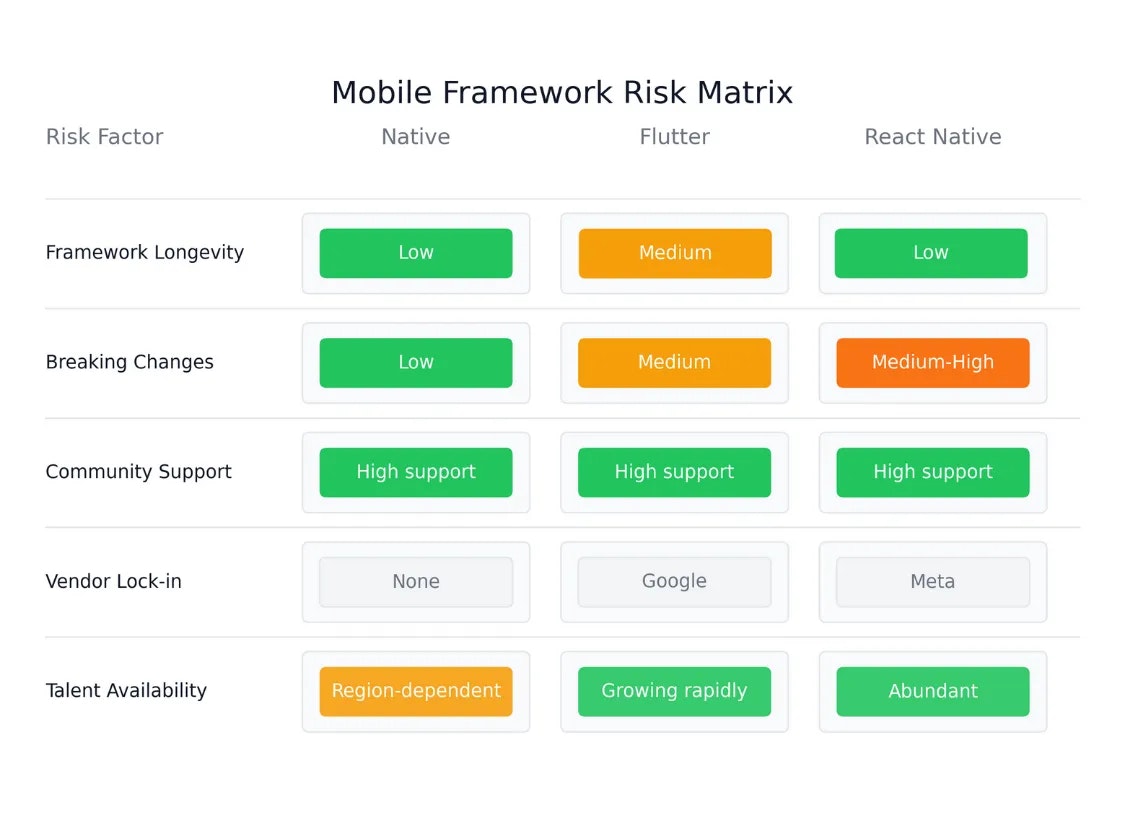“Flutter is fast.” “React Native is easier.” “Nothing beats Native.”
We’ve all heard these claims echoing through engineering meetings and product roadmap discussions.
In our technical benchmark report, we stress-tested Flutter, React Native, and Native (Swift/Jetpack Compose) with scientific rigor on real devices using identical workloads. That analysis revealed the raw performance winner.
This post translates those technical findings into a strategic decision framework built on three pillars: team capabilities (skills and experience), market timing & cost (development speed and cost efficiency), and framework capabilities (platform features, optimisation potential, long-term maintenance, and competitive advantage).
Why This Decision Defines Your Product’s Future
The mobile landscape has fundamentally shifted in 2025. Performance gaps have narrowed dramatically, but business stakes have intensified:
- User expectations are unforgiving: Sub-16 ms frame times and instant responsiveness are table stakes
- Market velocity: Late launches cost market share in compressed product cycles
- Engineering economics compound over years: Framework choice impacts hiring, retention, and maintenance costs for years
- Competitive moats: The right technical foundation becomes a sustainable advantage
The wrong framework choice doesn’t just slow development: it compounds into months of delays and hundreds of thousands in additional engineering costs.
2025 Market Reality: Performance Is No Longer the only Deciding Factor
Cross-platform frameworks now deliver 95–98% of native performance in real-world scenarios. The performance gap that once justified native-only strategies has largely disappeared.
Current market adoption reflects this shift:
- Flutter leads cross-platform adoption at 46% vs React Native’s 35%
- Flutter’s GitHub momentum: 172K stars vs React Native’s 123K
- Regional preferences: Flutter dominates Asia/Europe, and React Native remains strong in North America.
The strategic question has evolved from “Which is fastest?” to “Which aligns with our business objectives and team strengths?”
Benchmarks That Translate to Business Decisions
From our lab results:
Part 1: Lab-Tested Frame Times and Stability
Part 2: Memory vs Smoothness Trade-Off
Strategic Translation:
Native
- Balanced frame times (~17 ms) with very low jank (1.4%).
- Lowest memory footprint of the three.
- Business meaning: Best choice when you’re building hardware-heavy or memory-sensitive apps: think AR, real-time video, or high-performance consumer experiences where efficiency is non-negotiable.
Flutter
- Frames rendered in under 2 ms, leaving huge headroom within the 16 ms budget. Zero dropped frames, zero jank.
- Higher memory usage compared to Native, but within acceptable range for modern devices.
- Business meaning: Delivers native-grade smoothness plus faster cross-platform launches. Ideal for enterprises and startups alike where time-to-market and consistent UX across iOS and Android matter more than squeezing the last 50MB of RAM.
React Native
- Frame times near native (~16 ms) but with higher dropped frames (15.5%).
- Memory usage is higher than Native, often worse than Flutter depending on workload (especially with heavy JS objects held in memory).
- Business meaning: Solid option for business apps where ecosystem maturity and developer availability drive the decision. Works well for dashboards, workflows, and internal apps, but less suited for UX-critical, animation-heavy products.
In simple words:
Native: Efficiency first, the leanest memory and hardware-level performance.
Flutter: Smoothest UI with cross-platform speed; memory trade-off is worth it for most businesses.
React Native: Reliable for business apps, but not the go-to if buttery smoothness is mission-critical.
Engineering Effort: How Much Faster Can You Ship?
To ensure our engineering effort (EE) estimates are realistic and reproducible, we based them around a DoorDash/Deliveroo-style food delivery app.
This type of product is UI-rich, integration-heavy, and performance-sensitive, which makes it ideal for comparing Flutter, React Native, and Native builds.
Assumptions for EE
For a food delivery app build, the total engineering effort for cross-platform development (Flutter/React Native) is about 46 developer-days, while native requires roughly 92 developer-days if done sequentially. With core feature development taking about 31 developer-days per platform, native delivery times double when done sequentially, though parallel native teams can match cross-platform calendar time. Cross-platform’s shared codebase allows both platforms to be built in roughly 31–34 developer-days combined. Quality assurance in native requires separate passes for each platform (about 1–1.5 months each), whereas cross-platform can reuse most test scripts, reducing QA effort by roughly 25–30%. App Store and Play Store preparation takes 2–3 weeks per platform for both native and cross-platform.
Key takeaways
- Total effort: Cross-platform (Flutter/React Native) takes 46 developer days total, while native apps require 92 developer days sequentially (per platform).
- Parallel native teams: Running two native teams in parallel can match cross-platform delivery time, but it doubles resource requirements.
- Shared code advantage: Cross-platform builds iOS and Android together, avoiding duplicated work.
- Faster QA: Cross-platform testing is 25–30% quicker since most test scripts are reused across platforms.
- Simpler store submission: Cross-platform needs only one store prep cycle for both platforms, versus two for native.
- Speed-to-market winner: For launching on both platforms quickly and with fewer resources, cross-platform generally wins.
Clarification Note:
The engineering effort, timeline, and performance numbers provided above are modelled estimates, not direct measurements from a single live project. They’re based on industry-average productivity rates, common app complexity (using a food delivery reference app), and the typical efficiencies offered by Native, Flutter, and React Native frameworks. While these figures give a valuable benchmark and strategic guidance for planning, actual results will vary depending on team experience, project scope, and unexpected obstacles. For real-world projects, it’s best to treat them as guidelines, ranges subject to adjustment, not fixed predictions.
Always validate against your own team’s past data where possible before finalizing product plans.
Business Impact of Choosing the Right Framework
Grounded in a real-world, high-integration food delivery app, our engineering effort (EE) analysis reveals that both Flutter and React Native reduce development time by approximately 3 to 4 months compared to Native builds, all while maintaining feature parity. In engineering terms, this equates to 46 developer-days for cross-platform frameworks versus 92 developer-days for sequential Native builds. This reduction translates into substantial time-to-market acceleration and significant budget savings, allowing product teams to deliver faster without compromising on quality or scope.
Strategic Decision Framework by Business Priority
Maximum Performance & Device Integration (Swift / Android Native)
Peak performance with full OS API access and no bridging overhead.
Rapid Cross-Platform Launch with Premium UI (Flutter)
High code reuse of around 85–90 percent, with pixel-perfect design consistency.
Leverage Existing Web/JavaScript Talent (React Native)
Familiar technology stack that enables the shortest developer onboarding.
Long-Term Feature Parity & Complex Animations (Flutter)
Minimal platform divergence combined with a superior animation framework.
Hardware-Intensive or OS-Critical Features (Swift / Android Native)
Direct platform APIs that allow maximum hardware optimization.
Budget-Constrained MVP with Future Scaling (React Native)
Fast initial development and access to a large talent pool.
Other Factors to Weigh
Beyond performance, cost, and speed-to-market, there are additional dimensions that can make or break your framework decision:
Strategic Factors Today:
- Talent Availability → The depth of the hiring pool for each framework in your target region directly impacts your ability to scale teams, replace key talent, and control salary inflation. For example, React Native’s JavaScript base may make finding mid-level engineers faster in North America, while Flutter talent is growing rapidly in Europe and Asia-Pacific.
- Future Platform Changes → Apple’s and Google’s OS policies, API deprecations, or privacy mandates can alter your technical roadmap overnight. A framework tightly coupled to a single vendor (e.g., Flutter with Google) may gain fast access to new capabilities but could also be more exposed to policy shifts.
- Dependency Risk → Framework longevity and community health matter as much as features. Look at release cadence, contributor diversity, and corporate stewardship. A stagnating or fragmented community increases long-term maintenance costs and migration risks.
- Scalability of Architecture → Consider whether the framework supports clean modularization, feature flagging, and mature CI/CD pipelines. As your product grows, these traits will determine whether your architecture enables rapid feature delivery or slows to a crawl under technical debt.
Emerging Trends to Watch:
- Flutter’s Multi-Platform Vision → Expanding beyond mobile to web, desktop, and embedded systems
- React Native’s New Architecture → New Architecture improving performance and developer experience
- Native Platform Maturity → SwiftUI & Jetpack Compose improving rapidly
- AI Integration Advantage → Native frameworks leading in on-device ML model integration
- Privacy & Compliance → Platform-specific privacy APIs requiring native implementation. Region-specific requirements potentially favoring native solutions
Risk Assessment & Mitigation Strategies
Technology Risks
Migration & Hybrid Strategies
- Progressive Enhancement: Start cross-platform, migrate performance-critical components to native
- Modular Architecture: Native core services with cross-platform presentation layer
- Feature-Based Decisions: Use different frameworks for different app modules based on requirements
When to Reconsider Your Choice
Your framework decision isn’t permanent. Consider strategic pivots when:
- Performance bottlenecks emerge that can’t be optimized within current framework
- Platform-specific features become critical to competitive advantage
- Team composition changes significantly (skills, size, location)
- Market dynamics shift (new platforms, regulatory requirements)
- Framework ecosystem shows signs of decline or major architectural changes
Executive Takeaway
The optimal framework choice aligns three critical dimensions:
1. Product Requirements (performance, features, platforms)
2. Team Capabilities (existing skills, hiring market, learning curve)
3. Business Constraints (timeline, budget, long-term strategy)
2025 Reality Check: Cross-platform frameworks have eliminated the performance penalty that once made native mandatory. Today’s decision should prioritize strategic fit over raw benchmarks.
Default recommendation: Start with Flutter for most new builds. Choose Native for extreme performance/hardware needs, React Native when you have strong JavaScript depth.
Success Metric: The right framework choice accelerates your time-to-market by 3–4 months while reducing long-term engineering costs by 40–50%.
The best framework is the one that aligns your product goals, team strengths, and time-to-market needs, not just raw performance numbers.
Benchmarks give you performance truth in the lab.
Business metrics give you predictability in the boardroom.
Ready to choose the right framework? At SynergyBoat, we help you go beyond benchmarks, ensuring a framework decision that’s strategically right, not just technically fast.


